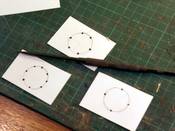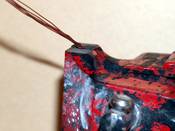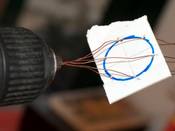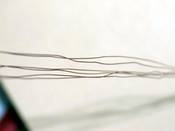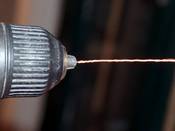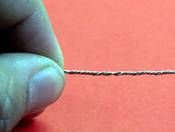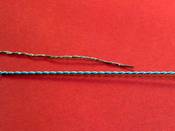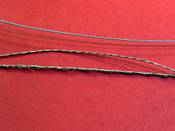1⁄35Making Tow Cables
15
Comments
Make realistic quick and cheap tow cables for use on armor and dioramas.
Making tow cables is an issue that has been talked some time before, but I felt that some improvements will help to even make the process better.
Tools - Materials: You will need:
Masks: I call my templates masks since you see different stuff in front and behind them!
Cut a square piece of your mask material large enough to easily host a circle with a diameter of an inch or less, but surely not more than an inch. I have found that 1.6 - 1.8 cm is the best diameter for this task.
Draw a circle evenly spaced on your mask. Measure with protractor or compass, or other way that suits you, and evenly divide the circle and drill 4, 6, 7, 8, 10 holes, in equal spaces on the circles circumference (outer line). The number of holes will affect the thickness of the tow cable. More holes makes a thicker tow cables (make one mask for every different number of holes). As you increase the number of pieces of wire, you make the process a bit more difficult, due to thickness.
The wire pieces have to be straight with no small folds or any kind of curl. If there are any of these defects it will cause the wire to simply break during twisting.
So since you have made your masks you are ready to start!!!! Grab 4 pieces (or the number of holes in your mask) of wire all of equal length, and twist their end together to a common one and secure it to the bench vise.
Pull them enough to straighten them out and insert each one of the wires through the holes of the mask. Then you twist them all together safely, and you insert them in the power tool chock and secure them by tightening the chock.
Now it's the deal!!! You set the power tool speed to the lowest setting and be really nice/easy on the trigger not accelerating like a madman on a highway. You need this part to be slow and easy. Start twisting the cables at the same time push the mask towards the bench vise at the same speed. While the twisting is going on try to keep wire pieces straight and don't pushing to much with the power tool or your hand!!!
You'll see like magic in less than 10 seconds; a perfect tow cable to arise between the vise and the power tool. Stop twisting, release the ends and you are done.
Things you need to be careful of include, the scaled down thickness of the real ones so you don't make anything unrealistic, the wire gauges you'll be using, and do not make a big circle on the masks because this can cause the wires to break from the twisting tension. I hope you like that little tip, and that will help you make perfect and above all cheap and quick, tow cables for your own armor models and dioramas.
Making tow cables is an issue that has been talked some time before, but I felt that some improvements will help to even make the process better.
Tools - Materials: You will need:
- wire pieces of different gauges, at desired length,
- a bench vise
- a motor tool with speed adjustment capability
- some pieces of plasticard - styrene sheet
- thin metal or whatever possible to make some templates
Masks: I call my templates masks since you see different stuff in front and behind them!
Cut a square piece of your mask material large enough to easily host a circle with a diameter of an inch or less, but surely not more than an inch. I have found that 1.6 - 1.8 cm is the best diameter for this task.
Draw a circle evenly spaced on your mask. Measure with protractor or compass, or other way that suits you, and evenly divide the circle and drill 4, 6, 7, 8, 10 holes, in equal spaces on the circles circumference (outer line). The number of holes will affect the thickness of the tow cable. More holes makes a thicker tow cables (make one mask for every different number of holes). As you increase the number of pieces of wire, you make the process a bit more difficult, due to thickness.
The wire pieces have to be straight with no small folds or any kind of curl. If there are any of these defects it will cause the wire to simply break during twisting.
So since you have made your masks you are ready to start!!!! Grab 4 pieces (or the number of holes in your mask) of wire all of equal length, and twist their end together to a common one and secure it to the bench vise.
Pull them enough to straighten them out and insert each one of the wires through the holes of the mask. Then you twist them all together safely, and you insert them in the power tool chock and secure them by tightening the chock.
Now it's the deal!!! You set the power tool speed to the lowest setting and be really nice/easy on the trigger not accelerating like a madman on a highway. You need this part to be slow and easy. Start twisting the cables at the same time push the mask towards the bench vise at the same speed. While the twisting is going on try to keep wire pieces straight and don't pushing to much with the power tool or your hand!!!
You'll see like magic in less than 10 seconds; a perfect tow cable to arise between the vise and the power tool. Stop twisting, release the ends and you are done.
Things you need to be careful of include, the scaled down thickness of the real ones so you don't make anything unrealistic, the wire gauges you'll be using, and do not make a big circle on the masks because this can cause the wires to break from the twisting tension. I hope you like that little tip, and that will help you make perfect and above all cheap and quick, tow cables for your own armor models and dioramas.
Comments
Realistic end pieces can be made in a number of ways
1. Fishing tackel eyelettes
2. Scratch made wire loops
3. Cheap jewelry connectors.
use some CA to connect and then wrap a bit of foil around to hide the connection and make it looked like a metal wrap.
JAN 21, 2005 - 08:07 AM
Thank you Costas, that is a good article.
Thanks Scott for the info on the end connectors.
JAN 21, 2005 - 09:30 AM
Very nice. I usually use very thin wire (26? gauge). I cut one long strand, fold it over, and twist it together (power drill is helpful, but I just use my hand and eyeball it). I do this a couple of times depending on the size I want. Typically three works well. I then take the two or three twisted-pairs and twist them together. Any more than three and the final twisting gets clunky. With a little practice, you get a good tow cable, and with two twisted pair, you get great radio wires and "rope".
Jeff
JAN 21, 2005 - 03:59 PM
wELL i just think that this kind of techniques , simple and cheap are the fun of modelling . Soon i ll come back with some other stuff i am practising on . Keep safe guys.
Thanks Scott on the additional tips
Costas
JAN 23, 2005 - 05:51 PM
Your right Costas,
nothing better than building things ourselves. Or better yet, inventing and sharing!
Bruce
JAN 23, 2005 - 05:57 PM
OMG - I will NEVER user another OOTB tow cable again.
I just used this tip and it produces FANTASTIC results.
I must give you a heads up. The first time you do this wrangling all those threads of wire and keeping the kinks out was a bit trying. I already see where I've learned how to better handle this with the way you do the intial threading.
The results FAR OUTWEIGH the finiky nature of the setup.
GREAT TIP Costas
JAN 30, 2005 - 03:50 AM
Its good that people see the usefulness of easy and costless tips . Also i believe that this is a way for new modellers to add accuracy and details in their models without having the "badget fear" on their heads.
I d be really helpfull if people could post here some of their makings
Costas
JAN 30, 2005 - 07:40 PM
Copyright ©2021 by Costas Rodopoulos. Images and/or videos also by copyright holder unless otherwise noted. The views and opinions expressed herein are solely the views and opinions of the authors and/or contributors to this Web site and do not necessarily represent the views and/or opinions of Armorama, KitMaker Network, or Silver Star Enterrpises. All rights reserved. Originally published on: 2005-01-21 00:00:00. Unique Reads: 19489





